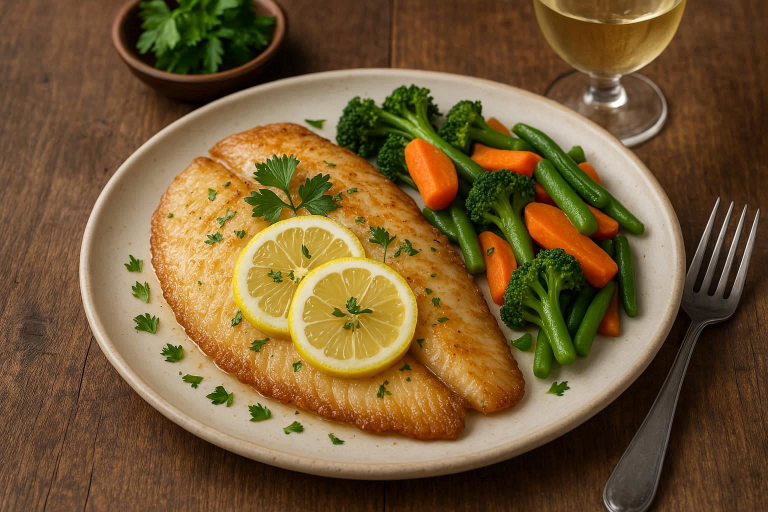Tilapia is a mild, lean fish that cooks fast, which makes it a weeknight favorite for healthy meals. The key to great tilapia is timing. Cook it long enough to be safe and flaky, but not so long that it turns dry. Knowing the right cooking time helps you get tender, juicy, and flavorful fillets every time.
In this guide, you’ll find practical, trustworthy tips based on widely accepted food-safety guidance and simple home-kitchen best practices. We’ll cover cooking times at different oven temperatures, how to cook tilapia in foil for extra moisture and easy cleanup, and quick stove methods for pan-searing or sautéing. You’ll also learn how thickness affects doneness, and how to check for a safe internal temperature (145°F) and that “flakes easily” finish. With these basics, you can cook tilapia well—fast, safe, and delicious.
How to Cook Tilapia in the Oven
Baking tilapia is simple and reliable. The oven gives even heat, so fillets cook at the same pace. It’s hands-off, too. Line a sheet pan Guide to Mastering Everyday Cookin and cleanup takes minutes. This method keeps the fish moist and lets spices shine.
Step-by-step
- Heat the oven to 400°F (204°C). For thicker fillets, 375°F works well. For faster browning, use 425°F.
- Pat fillets dry. Surface moisture causes steaming, not roasting.
- Lightly oil a lined sheet pan, or rub a little oil on both sides of the fish.
- Season with salt and pepper first, then add flavor: garlic powder, paprika, and lemon zest; or olive oil, minced garlic, and fresh herbs. Add lemon slices if you like.
- Arrange fillets in a single layer. Do not overlap.
- For extra moisture and easy cleanup, loosely cover the pan with foil; uncover for the last 2 minutes if you want light browning.
- Bake until the fish flakes and hits 145°F on an instant-read thermometer. As a guide: at 400°F, most 1-inch fillets take 10–12 minutes; at 375°F, 12–15 minutes; at 425°F, 8–10 minutes.
- Rest 2 minutes. Finish with lemon and a touch of butter or extra-virgin olive oil.
This method is safe, consistent, and ideal for busy cooks.
How Long to Bake Tilapia at 400°F
Four hundred degrees Fahrenheit is a sweet spot for tilapia. It’s hot enough to create light browning on the surface, yet moderate enough to keep the flesh tender and moist. The quick roast also preserves delicate flavors, so simple seasonings—salt, pepper, lemon, herbs—stand out.
Time guide: For most fillets about 1 inch thick, bake 10–12 minutes at 400°F (204°C). Thinner pieces will lean closer to 10 minutes; slightly thicker pieces may need a minute or two more. The most reliable sign of doneness is an internal temperature of 145°F (63°C) and flesh that flakes easily with a fork.
Tips to prevent overcooking at 400°F
- Preheat fully. A steady 400°F gives predictable results.
- Pat dry and oil lightly. Moisture on the surface steams the fish and extends time.
- Use a single layer. Crowding raises humidity and slows browning.
- Match thickness. Bake fillets of similar size together; remove thinner pieces first.
- Check early. Start checking at the 8-minute mark with an instant-read thermometer.
- Mind pan type. Dark pans brown faster; consider checking a minute sooner.
- Rest briefly. Pull at 145°F (or 140–145°F if you prefer very moist) and rest 2 minutes; carryover heat finishes the job.
These steps keep tilapia juicy, flaky, and never dry.
How Long to Bake Tilapia at 350°F
Baking tilapia at 350°F (177°C) uses gentler heat, which helps the fish stay tender and moist. This lower temperature gives you a wider timing window, so the fillets cook through evenly without drying out. It’s a great choice for new cooks, thicker pieces, or recipes with sauces and vegetables.
Time guide: Plan on 15–20 minutes at 350°F for fillets around 1 inch thick. Thinner fillets may be done closer to 15 minutes; slightly thicker ones can take up to 20 minutes. As always, the most reliable test is doneness, not the clock: look for an internal temperature of 145°F (63°C) and flesh that flakes easily with a fork.
Why 350°F works well
- Moisture retention: Slower, even heat helps keep delicate muscle fibers from tightening and squeezing out juices.
- Even cooking: Edges and centers finish closer together, so you avoid dry tips and undercooked middles.
- Forgiving timing: A couple extra minutes is less likely to overcook the fish.
Pro tips for success
Pat fillets dry, oil lightly, and season with salt, pepper, citrus, and herbs. Arrange in a single layer. For extra moisture, bake in a loose foil packet or with a spoonful of broth or lemon-butter. Start checking at 14 minutes; pull at 145°F and rest 2 minutes before serving.
How Long to Cook Tilapia in Foil in the Oven
Foil packets make tilapia almost foolproof. The sealed pouch traps steam, so the fish stays juicy and tender. It also concentrates flavors from lemon, herbs, garlic, and butter. Cleanup is quick, and there’s little risk of the fillets drying out.
Step-by-step (foil packet method)
- Heat the oven to 400°F (204°C) or 350°F (177°C).
- Cut a large piece of heavy-duty foil for each fillet. Lightly oil the center.
- Pat the fish dry; season with salt and pepper. Add simple flavor boosters: lemon slices, minced garlic, paprika, fresh herbs, a drizzle of olive oil or a small pat of butter.
- Place the fillet on the foil. Fold the long sides up and over, then crimp the edges to seal, leaving a little headroom so steam can circulate.
- Set packets on a sheet pan. Bake until the fish flakes and reaches 145°F (63°C) on an instant-read thermometer.
- Rest 2 minutes; open carefully to avoid steam and spoon juices over the fish.
Time guide (in foil)
- 400°F: about 10–12 minutes for 1-inch fillets.
- 350°F: about 15–20 minutes, depending on thickness.
Check early if fillets are thin, and remove individual packets as they finish. This method delivers moist, flavorful tilapia with minimal effort.
How Long to Cook Tilapia on the Stove
Stovetop tilapia is fast, flavorful, and weeknight-friendly. High, direct heat gives you a crisp edge while keeping the flesh moist. It’s ideal when you want dinner in under 10 minutes.
Step-by-step (pan-sear / pan-fry)
- Prep: Pat fillets dry. Season with salt, pepper, and a simple blend like garlic powder, paprika, and lemon zest.
- Pan & fat: Use a nonstick or well-heated stainless pan. Add 1–2 tablespoons of oil (or oil plus a little butter). Heat over medium-high until the oil shimmers.
- Sear: Lay the fish down away from you. Don’t move it for 1–2 minutes; this builds a golden crust.
- Control heat: If the pan smokes hard, lower to medium. If there’s no sizzle, raise the heat slightly.
- Flip once: When edges turn opaque and the underside is browned, flip gently.
- Finish: Cook until the center turns opaque and flakes easily. Optional: baste with butter and a squeeze of lemon.
- Rest: Transfer to a plate and rest 1–2 minutes.
Time guide: For typical 1-inch fillets, cook 3–4 minutes per side. Thinner pieces may take 2–3 minutes; thicker pieces may need 4–5 minutes with heat lowered for the last minute. For food safety and best texture, pull at an internal temp of 145°F (63°C). Serve with fresh lemon and herbs.
Tips for Cooking Perfect Tilapia
Season simply, then build flavor. Start with salt and pepper. For the oven, try olive oil, lemon, garlic, and parsley; or paprika, cumin, and a touch of chili. For the stove, use quick rubs (garlic powder, paprika, lemon zest) or brief marinades (15–30 minutes) like lemon-herb, Cajun-lime, or soy-ginger. Add fat (olive oil or a small pat of butter) to carry flavor and keep the fish moist. Finish with brightness—fresh lemon, chopped herbs, or a light drizzle of flavored oil.
Avoid common mistakes
- Overcooking: Check early and often. Thin fillets cook fast. Pull when the center reaches 145°F (63°C).
- Undercooking: If the center is still translucent and resists flaking, give it another minute and recheck.
- Flavor imbalance: Season with salt first, then layer spices. Balance richness with acid (lemon, vinegar) and keep sugar low at high heat to prevent burning.
- Poor texture: Pat fillets dry; moisture causes steaming. Don’t overcrowd the pan or sheet tray.
Doneness cues
Tilapia is done when it’s opaque throughout and flakes easily with a fork. An instant-read thermometer is your most reliable tool. Aim for 145°F at the thickest point, and then rest for 1–2 minutes. These habits deliver juicy, clean flavors every time.
Conclusion
Here’s a quick recap so you can cook tilapia with confidence. At 400°F, most 1-inch fillets bake 10–12 minutes for light browning and juicy flesh. At 350°F, plan 15–20 minutes for gentle, even cooking. In foil, expect about 10–12 minutes at 400°F or 15–20 minutes at 350°F, which locks in moisture and flavor. On the stove, pan-sear 3–4 minutes per side for a crisp edge and tender center. As always, check doneness with an instant-read thermometer—aim for 145°F (63°C).
Choose the method that matches your goal: want crispy? Go stovetop or 400°F. Prefer moist and hands-off? Use foil. Need extra-tender and forgiving? Bake at 350°F. Thickness matters, so start checking early and rest fillets for a minute or two before serving.
Call to Action
I’d love to hear from you. Share your best tilapia recipes, spice blends, or weeknight tricks in the comments. What oven temp works best for your fillets? Any great pan sauces? If you’re new to cooking fish, try oven-baked tilapia at 400°F tonight: pat dry, oil lightly, season with salt, pepper, and paprika, add lemon, and bake 10–12 minutes. Then tell us how it turned out! Drop photos, timing notes, and ideas.

